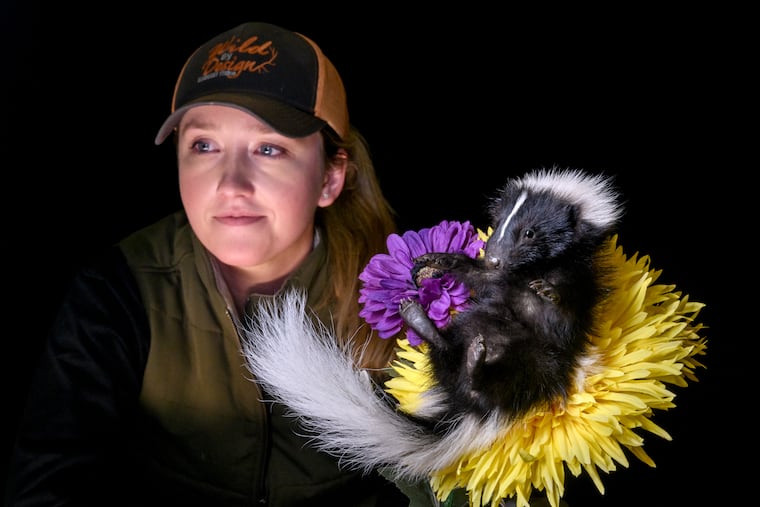Master of mammals: Pennsylvania taxidermist racking up ribbons
Pennsylvania has approximately 1,500 licensed taxidermists, with tens of thousands nationwide.

SEVEN SPRINGS, Pa. — She came hobbling into the conference center with torn ankle ligaments, a small cardboard box containing a dead baby skunk, and a reputation for racking up blue ribbons in the exacting world of competitive taxidermy.
Heather Miller’s friend carried her coyote. It turned heads.
“I do mammals,” Miller said. “I don’t do birds. I don’t do fish. I have an appreciation for a pretty duck, but I really like things you can put expression into.”
The 41st Pennsylvania Taxidermy and Wildlife Art Championships were still setting up in the exhibition hall of a large ski resort here in Western Pennsylvania earlier this month. Bizarre polyurethane molds of deer and bear heads, looking almost like butter carvings, were being hung on the walls. Advertisements for “hide paste,” a concoction that helps make the dried animal skins stick to the molds, were everywhere. Attendees would be able to buy it by the bucket. They could also go to seminars about molding fish heads and learn how to make small mammal ears.
Most people who saw Miller, 27, already knew her and her talent for making dead animals look live.
“Hey, Heather, that’s really cool," taxidermist Brian Hendricks said as he eyed up the coyote.
Miller grew up on a dairy farm in Halifax, a town of about 834 on the Susquehanna River, north of Harrisburg in Dauphin County. Miller grew up hunting and fishing with her father. After graduating from high school, she wanted to be a veterinarian, but after a little bit of college, she decided she’d rather focus on using her hands and went to apprentice at Bob Swope’s taxidermy studio in town.
When Swope retired, Miller bought his business and renamed it Wild by Design.
“When it comes to Heather, she was basically born an artist," Swope said. “She can paint and draw and never had an art class. That’s about 50 percent of the battle. The other half is blood and guts.”
The “gross factor” of taxidermy, Miller said, is not as bad as you would think — for the most part. Bears can be difficult.
“Bears are kind of like people,” she said. “Some are long-legged. Some are short-legged. And they’re so fat."
Last year, she entered the baby skunk in the World Taxidermy Championships in Missouri, and he placed in the top four. The event was launched by the trade publication Breakthrough in 1983.
“He’s a cute little bugger,” she said of the skunk.
Taxidermy first took hold in the 16th and 17th centuries, when scientists and explorers began collecting specimens all over the world and needed ways to preserve them. Early forms of taxidermy seem crude today, paper mache molds without the plastics and preservative chemicals that now keep them so lifelike.
Today, the animals usually are taken by hunters or trappers, or purchased from sanctuaries after they die. Their hides are cleaned and placed onto the molds, posed in countless ways. Taxidermists use airbrushes, even droplets to recreate condensation on animals’ noses.
There are approximately 1,500 licensed taxidermists in Pennsylvania. The National Taxidermy Association in Montana hasn’t counted them countrywide but says they number in the tens of thousands. Online estimates put taxidermists’ average salary at $44,373.
The bulk of taxidermy work in Pennsylvania, Miller said, is whitetail deer “shoulder” mounts, which feature the deer’s head, neck, shoulders and, of course, antlers. Hunters take countless pictures of their deer and the taxidermists use the hide and antlers to recreate the look. The cost of a typical whitetail shoulder mount ranges from $400 to $700 dollars.
“In a year, I’ll do between 300 and 400 pieces. It gets to be a lot,” she said. “You get some bobcats, coyotes, fox, too. The normal stuff.”
BJ Fornino, who negotiates sales of taxidermy pieces, came to the show to look for talent and perhaps find pieces to commission. She said Pennsylvania’s convention is one of the best in the nation. The worldwide market for taxidermy is high, she said, and each country has each its own particular skill sets.
“There’s some bird talent in Europe, particularly in Great Britain," she said.
Some taxidermy pieces sell for up to $20,000, according to Fornino.
Hendricks, 61, said he’s made thousands of pieces over his career. When he worked on a hippopotamus, the skin alone weighed 300 pounds after it was shipped from the tannery. The most impressive thing he’s mounted?
“Probably a big polar bear,” he said. “I’ve done 14-foot crocodiles from Africa.”
No humans, though. That’s illegal.
Miller, a board member of the Pennsylvania Taxidermist Association, had two entries for the Pennsylvania convention. One was the skunk, which she named “Lil Waylon,” and the other was her coyote. Miller tries to tell a story through her taxidermy, like her coyote, licking a bloody paw after escaping from its second trap. On the stand that held the coyote, she embedded an old fur trap, and a small tag affixed to the wood read, “Third time’s a charm.” She estimates it took her 80 to 100 hours to complete.
Entries start with 100 points and every flaw knocks the score down. Blue ribbons require 90 to 100. On Saturday night, Miller traded her walking boot for dress shoes and collected more than a half-dozen awards for her coyote. The wins propelled her into the masters division for the first time.
“It sounds like I’m bragging but yeah, I’ve won a lot of blue ribbons," she said.
Miller longs to move out west, to Idaho, or Wyoming, perhaps Alaska, to work in studios that focus on big game and predators. She has a black coyote she wants to show at the world championships next year.
“I know exactly what I want to do,” she said. “But I’m going to save it for the show.”